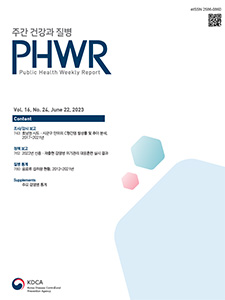Current Issue
Vol.16 No.24, June 22, 2023
-
Surveillance Reports 2023-06-22
 0
0
 954
954
 165
165
Analysis of the Provincial- and Municipal-level Hepatitis C Incidence Rates and Trends in the Honam Region, 2017-2021
Young-Sook Choi, Sang-Yong Eom, Jeong-Hee Yu
Public Health Weekly Report 2023; 16(24): 743-761 https://doi.org/10.56786/PHWR.2023.16.24.1 Abstract
AbstractThe World Health Organization has proposed the goal of eliminating viral hepatitis infection by 2030. Policy research and projects to reduce the incidence rate are ongoing in local governments where hepatitis C infection is common. However, a clear basis for decision-making is required at the regional level. Therefore, Honam Regional Center for Disease Control and Prevention intends to determine the incidence rate and trend of hepatitis C virus (HCV) infection by municipal levels in the Honam region, where HCV infection is prevalent. The analysis of data reported to the Korea Disease Control and Prevention Agency in the Honam region from June 3, 2017, to December 31, 2021, revealed that the incidence rate of HCV infection in the Honam region was the highest in 2018 and the lowest in 2021. It varied by up to 1.9 times in cities and provinces and 74.9 times in municipalities. The result of join point regression analysis revealed a statistically significant decreasing trend during the mandatory surveillance period. In addition, there were differences in the incidence rates of HCV infection in the Honam region according to the cities, provinces, municipalities units and gender. The statistical indices can be selected and combined according to the policy direction or objectives of the local government. Hopefully, these findings will serve as an objective basis for making decisions necessary to prevent and manage HCV infection in the Honam region.
-
Policy Notes 2023-06-22
 1
1
 1014
1014
 187
187
Results of Crisis Response Training for Emerging and Re-emerging Infectious Diseases Conducted by the Korea Disease Control and Prevention Agency in the Republic of Korea, 2022
Hee-Sook Kim, Hyungtae Ahn, Jungyeon Kim, Hyungmin Lee*
Public Health Weekly Report 2023; 16(24): 762-779 https://doi.org/10.56786/PHWR.2023.16.24.2 Abstract
AbstractOwing to the absence of treatments or vaccines for emerging infectious diseases (EIDs), early recognition and initial response are crucial. The Korea Disease Control and Prevention Agency (KDCA) has conducted simulation trainings for provincial and local governments and related agencies responding to public health emergencies since 2010 to strengthen their response capabilities. This study analyzed the results obtained from the training conducted in 2022 to identify areas for future improvement. The training comprised three modules (education on infectious diseases, tabletop exercises, and practice in using personal protective equipment) and covered five infectious diseases, including Middle East respiratory syndrome, Ebola virus disease, avian influenza virus infections in humans, Mpox, and coronavirus disease 2019. Institutional evaluation (17 provincial governments-16 trainings) was conducted using evaluation indicators, The trainees’ knowledge and attitudes toward EIDs as well as satisfaction from the training were measured through questionnaire surveys (ten questions each of pre- and post-knowledge attitude and ten questions on satisfaction; 5-point scale). Total 1,526 people participated in 16 trainings, and 811 surveys were analyzed. The institutional evaluation revealed an average score of 8 6.0 (range: 57–102, out of 110). The survey showed that 78.5% had less than 2 years of work experience related to infectious diseases, and 72.6% were receiving the training for the first time. Knowledge levels and positive attitudes toward EIDs increased by 15.6% and 7.0% after the training, respectively (p<0.05), and the ‘training satisfaction’ was found to be 4.5. These results show that, given the short career span of trainees, annual periodic training is required, and pre-training for provincial governments is needed to reduce the capacity gaps. Furthermore, the development of training scenarios and finding ways to increase the participation of related organizations are also needed.
-
QuickStats 2023-06-22
 0
0
 2381
2381
 468
468
Trends in the Intake of Non-alcoholic Beverages, 2012-2021
Public Health Weekly Report 2023; 16(24): 780-781 https://doi.org/10.56786/PHWR.2023.16.24.3

pp. 1433~1461
Most Keyword
?
What is Most Keyword?
- It is the most frequently used keyword in articles in this journal for the past two years.
Most Read
-
Waterborne and Foodborne Disease Outbreaks in the Republic of Korea, 2023
Myung-Jae Hwang, So Yeon Park, Hyungjun Kim, Se Jeong Yang, Sungchan Yang, Jin Seon Yang
Public Health Weekly Report 2025;18: 17-32 https://doi.org/10.56786/PHWR.2025.18.1.2 -
Implementation Plan for the Coronavirus Disease 2019 Vaccination for the 2024–2025 Season: Recommendations of the 6th Expert Committee on Immunization Practices
Hyewook Hwang, Wookeon Lee, Seohyeon Ahn, Young-Sook Choi, Seunghyun Lewis Kwon, Dongwoo Lee, Eun Hwa Choi, SokGoo Lee
Public Health Weekly Report 2025;18: 90-102 https://doi.org/10.56786/PHWR.2025.18.2.3
Editorial Office
+82-43-719-7569





 Full Text
Full Text Cite
Cite


